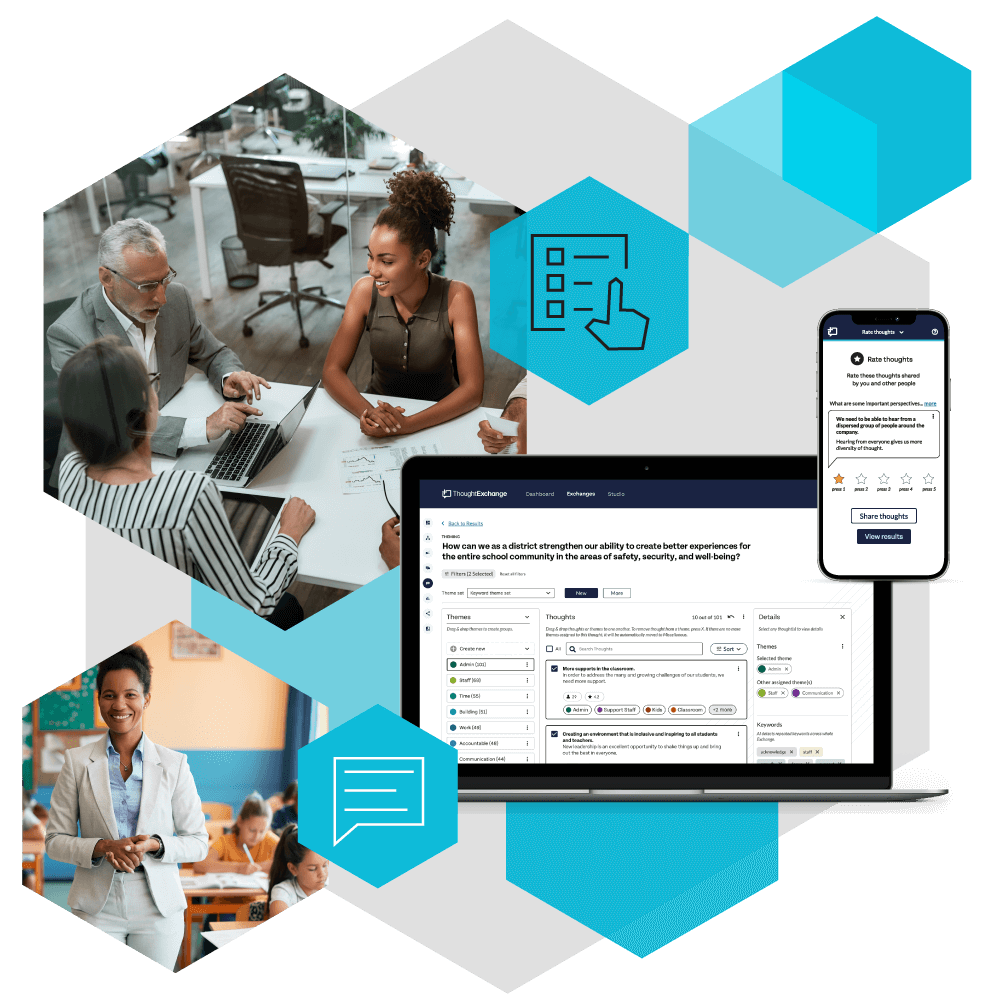







How to Choose the Best Student Voice Platform
Engaging your students in their education and listening to their unique insights and experiences ultimately contributes to their success. But how do you access your students’ honest opinions quickly and easily—and ensure you’re including them in the decision-making process?
Whether you’re improving your mental health strategy or implementing new technology in the classroom, the right student voice platform will make things easier. A comprehensive student voice engagement platform gets you from insights to action faster, engaging thousands of students while addressing their needs and helping them succeed.
Here’s how to choose the best student voice platform for your needs.
See ThoughtExchange in Action — Explore the Product Tour
In this Article
What is a student voice platform?
Student voice engagement platforms help education leaders streamline student voice initiatives. With the right software, leaders can gather feedback from tens, hundreds, or even thousands of students in just days.
Whether you’re working on improving your mental health strategy or safely and effectively implementing new tech, a student voice platform facilitates candid, collaborative student conversations that help districts understand and meet their students’ needs and realize their goals more quickly.
How to choose the right student voice platform
Types of student voice engagement—pros and cons
Types
Pros
Cons
Online polls
- Easy to set up
- Easy to participate in
- Quick answer to simple question
- Engages large groups
- Surface-level data—no insight into why participants respond a certain way
- Answers are pre-selected and subject to bias
- Can’t measure response intensity or sentiment
Pros
- Free for up to 100 participants
- Open forum for discussion (particularly for smaller groups)
Cons
- Can’t be scaled and still maintain quality of conversation
- Virtual meeting fatigue
- Paid plans for over 100 participants
- Requires note-taking and recording for later analysis
Pros
- Easy to set up
- Easy to participate in
- Quick answers to simple questions
- Engages large groups
- Offers quantitative and qualitative question options
Cons
- Surface-level data—no insight into why participants respond a certain way
- Answers to close-ended questions are pre-selected and subject to bias
- Answers to open-ended questions must be manually analyzed
- Usually just the first step in engagement, followed by weeks of focus groups and data analysis
Pros
- Classic survey and Exchange options. Use one or both depending on needs.
- Easy to set up an Exchange using templates
- Easy to participate in from any device at any time
- Scales easily from 10 to 10,000+ participants
- Offers quantitative survey questions
- Ask one open-ended question to get thousands of quality responses
- Access people’s real thoughts and insights instead of predetermined answers
- Anti-bias technology ensures participants and leaders engage ideas on merit, not on who’s sharing them
- Built-in AI analytics provide rich data as the conversation unfolds
- TE Advisor instantly summarizes data, identifies themes, and provides possible next steps. Ask custom prompts to get answers and ideas about how to run your next engagement
- AI and manual data analysis is done in minutes or hours instead of weeks
- Easy to export reports, presentations, and HTML pages for sharing results with participants and leadership
Cons
- Requires trust and transparency from leaders
- Costs are up front, but saves immense time and money in the long run
Three features your student voice platform needs to have
Whatever student voice engagement platform you choose, you’ll want to make sure it has the following features:
- Anti-bias: Gives each thought equal weight despite who said it. Allows students to voice their honest opinions without fear of judgment or reprisal.
- Themes: Allows users to quickly sort participant responses by keyword or sentiment, or create custom themes with an intuitive manual theming tool. Understand qualitative data through a quantitative lens with AI theming.
- Manual moderation: Flags inappropriate or hurtful thoughts based on criteria pre-set by the leader. Maintain respectful participation and builds trust in the process and platform.
What are some student voice survey questions I can use?
When eliciting student voice, you need to ensure you’re asking the right questions to meet your objectives. This is paramount to your initiative’s success.
Here are a few of our suggestions to get you started:
- What are some important perspectives and ideas you want school superintendents to consider about AI tools such as OpenAI's ChatGPT for teaching and learning?
- What motivates you to do your best at school?
- What are some things you are looking forward to, and what are some things that concern you about this year at school?
- What are the most important things you want to share about your school experience so far this year?
- Graduates, what advice do you have to share with your younger classmates?
Make the most of student voice with ThoughtExchange
Whatever issues your district is facing—students are a critical part of the solution. And with the right student voice engagement platform, you can understand their needs and collaborate to create positive change in your district.
A comprehensive student voice platform helps education leaders tap into their students’ collective intelligence—and find solutions that work.
Dr. Rui Dionisio, Superintendent, Ramapo Indian Hills





